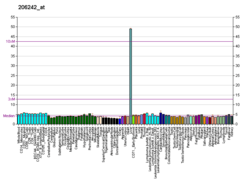Transmembrane 4 L6 family member 5 is a protein that in humans is encoded by the TM4SF5 gene.[5][6]
The protein encoded by this gene is a member of the transmembrane 4 superfamily, also known as the tetraspanin family. Most of these members are cell-surface proteins that are characterized by the presence of four hydrophobic domains. The proteins mediate signal transduction events that play a role in the regulation of cell development, activation, growth and motility. This encoded protein is a cell surface glycoprotein and is highly similar in sequence and structure to transmembrane 4 superfamily member 1. It may play a role in cell proliferation, and overexpression of this protein may be associated with the uncontrolled growth of tumour cells.[6]
Further reading
- Berditchevski F (2002). "Complexes of tetraspanins with integrins: more than meets the eye". J. Cell Sci. 114 (Pt 23): 4143–51. PMID 11739647.
- Lee SY, Kim YT, Lee MS, et al. (2006). "Focal adhesion and actin organization by a cross-talk of TM4SF5 with integrin alpha2 are regulated by serum treatment". Exp. Cell Res. 312 (16): 2983–99. doi:10.1016/j.yexcr.2006.06.001. PMID 16828471.
- Gerhard DS, Wagner L, Feingold EA, et al. (2004). "The status, quality, and expansion of the NIH full-length cDNA project: the Mammalian Gene Collection (MGC)". Genome Res. 14 (10B): 2121–7. doi:10.1101/gr.2596504. PMC 528928. PMID 15489334.
- Strausberg RL, Feingold EA, Grouse LH, et al. (2003). "Generation and initial analysis of more than 15,000 full-length human and mouse cDNA sequences". Proc. Natl. Acad. Sci. U.S.A. 99 (26): 16899–903. doi:10.1073/pnas.242603899. PMC 139241. PMID 12477932.
- Kaneko R, Tsuji N, Kamagata C, et al. (2002). "Amount of expression of the tumor-associated antigen L6 gene and transmembrane 4 superfamily member 5 gene in gastric cancers and gastric mucosa". Am. J. Gastroenterol. 96 (12): 3457–8. doi:10.1111/j.1572-0241.2001.05355.x. PMID 11774983.
- Wright MD, Ni J, Rudy GB (2000). "The L6 membrane proteins--a new four-transmembrane superfamily". Protein Sci. 9 (8): 1594–600. doi:10.1110/ps.9.8.1594. PMC 2144728. PMID 10975581.
- Gress TM, Müller-Pillasch F, Geng M, et al. (1996). "A pancreatic cancer-specific expression profile". Oncogene. 13 (8): 1819–30. PMID 8895530.




